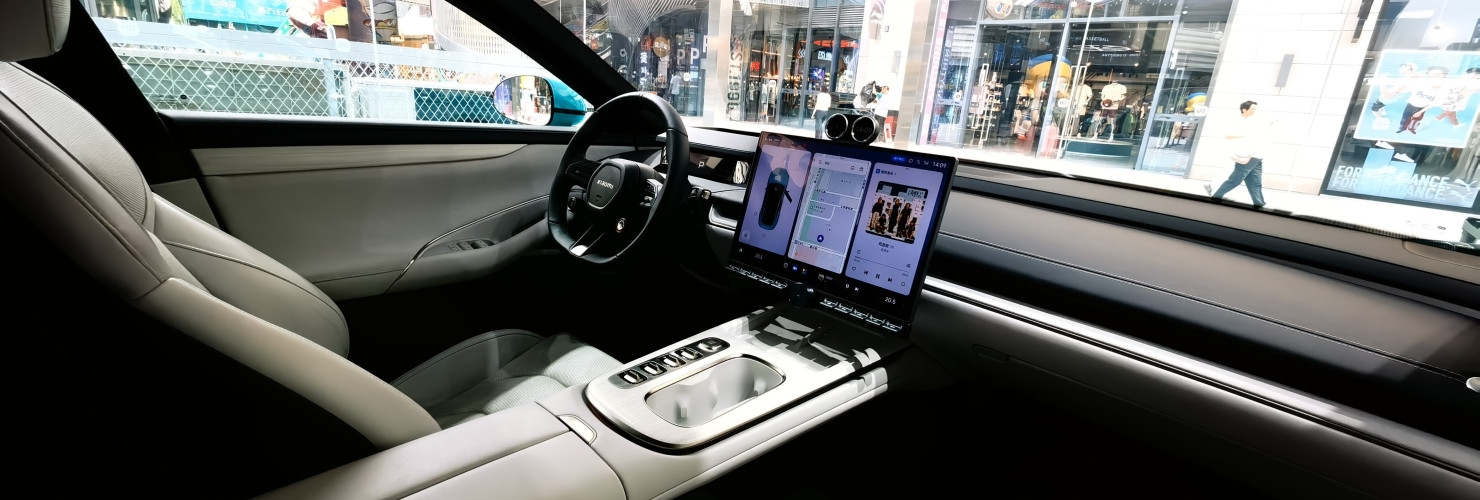

China’s EVs are AI-on-wheels, while European cars are still trying to get smart
European carmakers with their traditional excellence in producing driving machines seem to have a hard time innovating in electric vehicles (EVs). Wendy Chang and Antonia Hmaidi say that understanding the Chinese EV industry model may offer ideas for catching up.
China’s electric vehicle (EV) industry can now make vehicles with new technical features at dazzling speed. This model relies on deep integration with its AI sector to produce software for smart cockpits and smart driving, as well as leveraging the advanced battery supply chain in China. In contrast, European carmakers with their traditional excellence in producing driving machines seem to have a hard time innovating in EVs. Understanding the Chinese EV industry model may offer ideas for catching up.
The software + battery + basic car chassis formula allows tech companies to join the field and quickly create new cars. While an internal combustion engine (ICE) typically has hundreds of moving parts, an electric motor usually has two. Thus, electric vehicles can be seen as a more manageable technology, especially when it comes to mechanics, as much of the complexity is in the batteries or electronics. In addition, it is easier to iterate quickly, as, for instance, a new battery often does not need a change in the motor.
Because there is less differentiation in motors and technical specs, Chinese carmakers often distinguish their offerings with software and user experience. Cars have generous heads-up displays and infotainment systems, in essence big tablets on the dashboard that run standard software (often Android). This allows carmakers to take advantage of developments in smartphones and quickly iterate car-specific utilities. In addition, Chinese cars often feature AI-enabled advanced driver-assistance systems, or ADAS.
EVs profit from tech sector integration
China has long focused on EVs as a key driver of its growth and exports, using heavy subsidies and favorable domestic policies to aid the growth of the industry over the last decade. Thanks to Beijing’s clear dedication to EVs as a key area for development, all sectors are participating in its innovation. This applies especially to the tech sector, in accordance with the state’s guiding principle that AI should serve the real economy.
Deep integration with the tech sector means Chinese EVs come loaded with AI features. Baidu’s ERNIE Bot, China’s first answer to ChatGPT, is already available for voice control of in-car systems. Baidu also provides its high-precision mapping technology to automakers for navigation services inside China, including to Tesla. Huawei’s operating system provides, among other features, smartphone-like access to music, phone and messaging services. Both Huawei and Baidu have collaborated with many Chinese EV makers.
EV makers are also in fierce competition to develop self-driving capabilities. XPeng is one of the leaders in this arena, its ADAS system Xpilot often compared to Tesla’s Autopilot. The system enables cars to perform tasks automatically, such as changing lanes, overtaking, and self-parking. Driving data collected from such systems in turn feeds the company’s more advanced models, which are aiming at the next milestone – full autonomous driving, including in complex urban areas. Many competitors are also developing plans for Robotaxi services, which would feature fleets of unmanned vehicles.
In some cases, the tech companies are developing EVs themselves. Smartphone maker Xiaomi announced its first smart car to much fanfare in March, a mere three years after entering the EV sector. It achieved this accelerated timeline by collaborating with automaker BAIC Motor Corp. to produce the cars, which use an operating system developed by Xiaomi. The Xiaomi car epitomizes the collaborative approach of China’s EV industry – truly a smartphone on wheels.
Cheap and smart batteries are another Chinese advantage
China accounts for more than 50 percent of lithium-ion battery exports. Domestic producers have focused on cost-effective lithium iron phosphate batteries (LFP) with a range of up to 500km. A good charging network and quick charging allows Chinese cars to still be competitive, despite the fact that many European EVs have more expensive lithium nickel manganese cobalt oxide (NMC) batteries with a range of up to 700km. While competitors offer batteries with similar or even greater range to Chinese ones, China is has a commanding lead in battery costs.This confers significant price advantages to EV-makers using Chinese batteries, as the battery accounts for 40 percent of the cost of an electric vehicle.
When European and US consumers ponder switching to EVs, many worry about a change in lifestyle. Needing to stop and wait for recharging is a change Chinese consumers have been willing to adopt more quickly. Navigation software that includes route and charging plans and China’s dense network of chargers with enough capacity installed to deal with peaks mean driving an electric car in China requires less foresight than even traditional gasoline cars. As self-driving technology becomes the new attraction to some markets, traditional car companies that rely on selling the experience of driving as a joy in itself may struggle to compete.
The Chinese EV sector’s approach is not without drawbacks. The relatively lower barrier to entry creates too many carmakers, and many of them don’t survive, leaving customers with cars with no support. The piecemeal approach of building a vehicle means customers will have a harder time trusting a brand’s expertise in producing a safe, quality vehicle. Frequent software updates managed by car companies may leave vehicles vulnerable to cyberattacks. In this light, traditional car companies that produce unconnected driving machines can seem like a more dependable option.
European carmakers may be able to play to their strengths by upholding their reputation for high quality and safety standards. But to compete with Chinese EV makers, they need to start thinking about how to attract customers not only in “car” features but also in the “smart” ones. In a market that increasingly values software over pure “mechanics,” they will need to become more agile and focus more on software.
Some European companies have seen this. Audi, for instance, recently hired a management board member focused on software-defined vehicles, at the same level as a Chief Financial Officer or Chief Technical Officer. Volkswagen also announced a collaboration with XPeng to jointly build electric SUVs. More dedication to AI-enabled smart cockpit and smart driving features through broader collaboration with the tech sector will help speed up innovation in European EVs.

